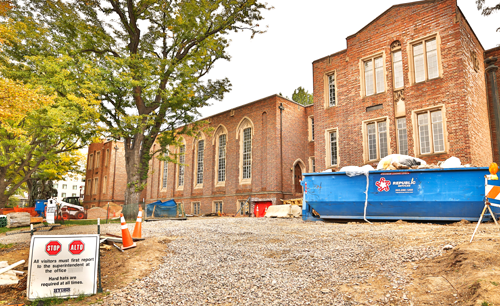
Construction on Margery Reed continues to progress and is scheduled to end in February with the building occupied by the Daniels College of Business (DCB) by the end of that month, according to Mark Williams, DCB Director of Facilities.
The biggest addition is three new classrooms for a total of eleven now in the building, in addition to a remodeling of the theater space. The project will cost Daniels $8.7 million, according to DCB Assistant Dean of Operations Christine Macmillan, and was originally scheduled to finish in March of next year.
When completed, the space will be used by DCB to host classes and presentations. Williams said the idea for DCB to take over another space on campus has existed for a long time.
“When we built the Daniels building initially, they wanted to have some auditorium space, but it would cost a whole lot more money,” said Williams. “So rather than putting an auditorium in Daniels we [planned] we would get a building at a certain point in time and be expected to remodel the building.”
Margery Reed now holds 11 classroom spaces, one of which is a tiered classroom while the remaining 10 are “mobile” classrooms, which allow professors and students to rearrange the layout of the seats and podium. Each classroom will be able to fit between 20 and 23 students according to Williams.
“We tried to make this a very flexible space,” Williams said. “We pulled a bunch of meetings together and tried to get a bunch of Daniels professors and got feedback from them… they were all pretty much in agreement they would like to be able to move stuff around.”
The theater space was also remodeled to add stadium seating able to fit 190 people. It will now be used for DCB presentations.
Macmillan said the building will be used primarily for Daniels students, and will continue to offer DCB undergraduate career counselors in addition to hosting the DCB Communications and Marketing office, the office of the undergraduate program, and classes. Additionally, the building will continue to host the university Strategic Communications Program.
Williams said the additional space was needed to help accommodate the number of classes and students in Daniels, which currently has 20 classrooms and nine small seminar rooms.
“We didn’t have any classroom space,” said Williams. “One of the things about Margery Reed is they have smaller classroom spaces, so we could even split up classes.”
According to Williams, Daniels raised money for the project through the Daniels Advancement Team, a team focused specifically on fundraising for DCB. They have primarily raised money by selling seats in the theatre to have names of donors or their relatives engraved on them for $1,000 each.
According to Macmillan, payment for the project also came from university funds, which paid for a new boiler and heating and cooling system for the building, as well as some of the general repairs.
Williams said DCB has focused on maintaining many of the elements of Margery Reed, which has been on campus since 1929, and selected architectural firm Schlader-Paul based on criteria that the architectural elements of the building would be left in place.
It has not been determined yet which DCB classes will be hosted in Margery Reed. However, Williams said that DCB would not use all of the space, and other departments on campus will be able to schedule classes in classrooms not being used by DCB.











